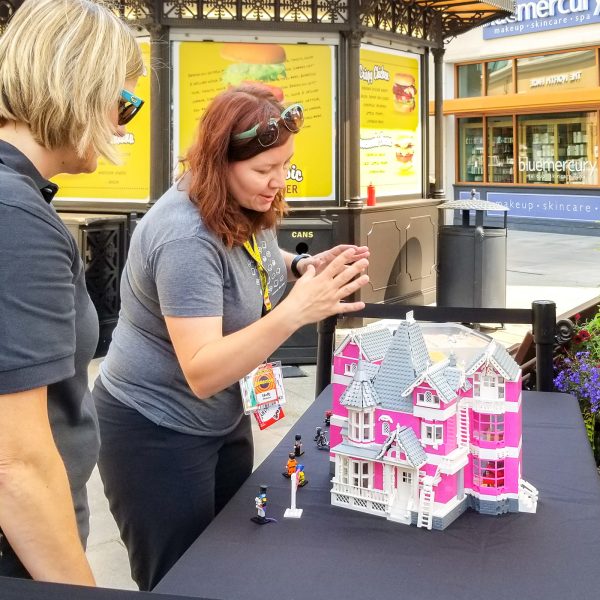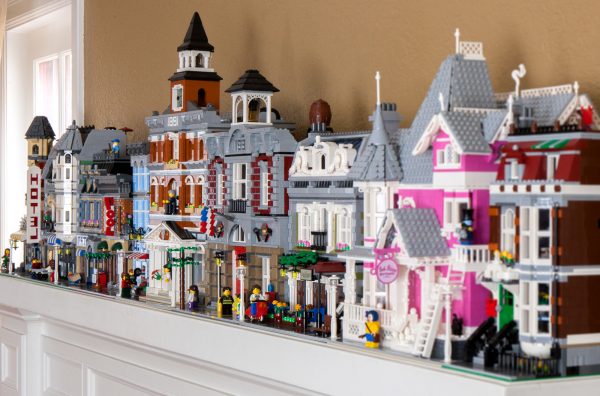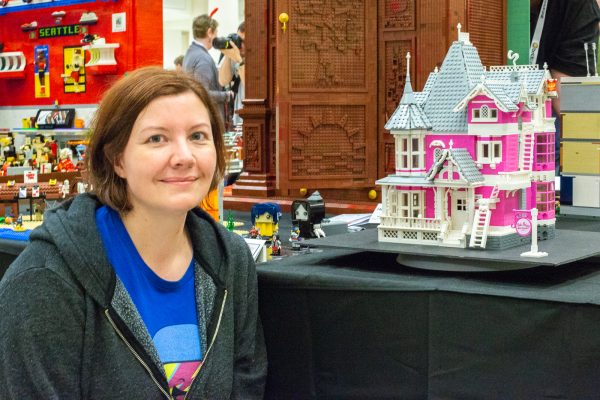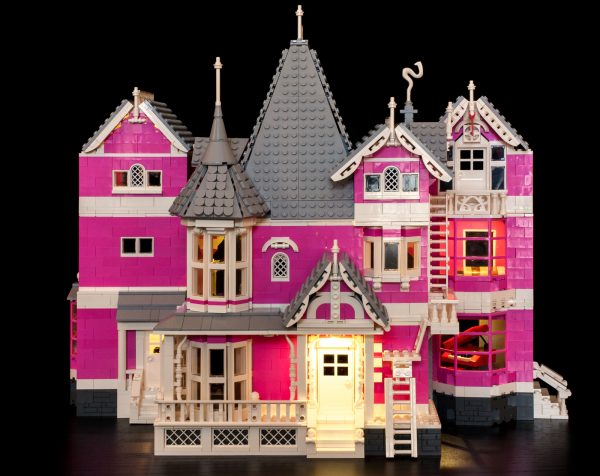Interview: Holly Webster’s Coraline House
Let’s learn how 3d digital artist Holly Webster combined her passion for LEGO and her close connection to the animated film Coraline into this amazing LEGO IDEAS submission.
Portland, Oregon is a haven for LEGO. We have an official LEGO store, numerous non-official LEGO brick re-sellers, multiple LEGO User’s Groups (PortLUG, and a LEGO railroad LUG called Great Northern LEGO Railway), and a huge fan-run convention called Bricks Cascade. Needless to say, ABS runs in the veins of many members of the community. We even have a LEGO Ideas 10k Club member, Grant Davis from PortLUG, whose Pop-Up Book will be released soon.
Today, we’re here to talk with another PortLUG member and LEGO Ideas entrant… Let’s meet Holly Webster, and learn more about her LEGO model of Coraline’s Pink Palace Apartment, based on the 2009 animated movie Coraline.
Holly Webster: I’ve worked as a visual effects artist on several Laika films now for over eleven years. I was first hired at the studio when Coraline was in production, and I’ll never forget the impression it left to see the practical house all lit up on set; it was truly magical. It’s one of the most iconic buildings in film history. It didn’t take long to start visualizing it in LEGO form; it just took a while to get around to it. Next year is Coraline’s 10 year anniversary, and it seemed the right time to redirect the spotlight on such an incredible and ground-breaking film.
Holly Webster: Unfortunately, Coraline is the only Laika film I did not get to work on. I was at the studio during the production, but there was not a huge need for digital effects artists on that film in particular, so I was working in other parts of the studio. Paranorman was my first feature film credit. I’m a big fan of both Neil Gaiman and Henry Selick, so it was tough being so close to the project without being able to contribute to it; but I’m glad I can appreciate it on a different level that I may otherwise not have been able to experience. It’s difficult to ever see the whole of it when you’ve worked (sometimes painfully) on sections at a time.
Holly Webster: Laika basically knew nothing about this until the design was nearly completed. I acquired permission to do the project some time ago, but that information was confidential. I tend to be pretty private with my projects. I was reluctant to show anyone for a long time until I felt pretty confident with the design. Once my visual effects supervisor caught wind of it, thanks to my husband who also works at Laika, he gave me a push to go ahead and show it off to some other folks at the studio. There’s been a lot of excitement, and they’ve been terrific in giving me plenty of support and encouragement while avoiding any sort of creative interjection whatsoever.

Coraline House LEGO Ideas submission in the foreground, Laika Studios Coraline model from the movie in the background.
Holly Webster: There were two difficult sections that took up the majority of the design time. The first was the little door in the living room. In the film, Coraline finds a little door in her new house that is initially bricked up, but later it magically opens to a tunnel that leads to a parallel universe. I found that parallel universes are a bit tricky to replicate in LEGO form, and given that I wanted to keep the layout of the house film-accurate, this meant that the door would actually open into the Other Father’s parlor. That doesn’t make a lot of sense. So after many, many, many different attempted techniques and combinations, I decided that instead of having a fixed wall between the living room and the parlor, I’d have the wall swivel out when the house is opened up and then I simply added bricks inside the door! A fairly simple and elegant solution that took way too long to figure out.
The other section that really tripped me up was the roofline. It was incredibly complicated to get all the angles to meet up. I wouldn’t consider it a flawless execution by any means, but I was getting to a point where I just needed to get it done. So once the math finally worked out and I’d hit the maximum piece limit, I had to leave it in a “good enough” state. This has truly been a lesson in letting go.
Holly Webster: My favorite detail is probably the spinning piano. It’s a really fun and memorable part of the film. I initially just had it on a turntable, but decided it wasn’t obvious enough that it spins, so I retrofitted the house with a gearbox to allow it to spin around with a motor or hand crank. Having a mechanical feature is always a nice bonus.
Holly Webster: It is painstakingly film accurate. I did a ton of research and obsessively watched the parts of the film where Coraline is exploring from room to room to figure out the exact layout, placement of doors, windows, and furniture, and made an effort to include as many detailed film references as possible, down to some custom printed parts like the painting of the “Boring Blue Boy” and Mr. Bobinsky’s flag. Of course a lot of concessions were made to keep this within the part limit and to an Advanced Modular standard, not to mention the limitations of available LEGO parts, but it’s as true a replica as I could manage.
Holly Webster: Yes, sort of. I started on the design long after the film was completed, so did not have access to any of the original sets or material. However, I did start by acquiring a floor plan, which was kind of rough. There’s a bit of wizardry that often happens with filmmaking. Doors and windows tend to move around and scales can change depending on the shot. The exterior did not necessarily match the interior, which is problematic, of course, when trying to replicate something in reality. I also wanted the house to be able to fit into an Advanced Modular lineup, so I adjusted it to fit those dimensions.
I also gave myself the extra challenge of having a hinged opening, so the layout shifted to accommodate all these constraints, but ultimately the flow remained the same. Most of this I had to sort out by just watching the film over and over again, but just as I was finishing up the digital design, they opened a Laika exhibit at the local Portland Art Museum and put the fabricated house on display. That would have probably been immensely helpful had it been on display much sooner, but it was at least nice to verify that things lined up pretty well. I was also able to acquire a little bit of original artwork for the printed elements. I used the “Boring Blue Boy” artwork as is, though I intend to eventually recreate the boy in minifigure form.
Holly Webster: I still work with a lot of the same people that worked on Coraline, so I talk to them all the time. Since I was basically done with the design before showing it to a lot of people at the studio, I didn’t tell many of them what I was up to while I was working on it.
I have had some fun conversations with our lighting engineer, Matt DeLeu. We were both at the museum setting up lights at the same time. He was fixing something on the original house while I was running lights through my LEGO house in preparation for a photo shoot of them side-by-side. The work he does is really incredible and adds such an exceptional element to the films. Seeing Coraline’s house lit up all those years ago was truly inspirational. He commented that the smaller you go, the more difficult it gets, so he expressed his admiration for my work as well.
Holly Webster: I really wanted to include Spink and Forcible’s basement apartment. I was kind of heartbroken to have to concede that it couldn’t really be done within the constraints. It wouldn’t have fit in a standard modular lineup, would have required too many more parts, required that many more figures, and going underground makes for some other complications. I envision this as an add on, maybe not through IDEAS, but something I will personally add on myself and put on display when I’m able to circle back around.
Aside from that, I ran into a lot of color limitations where I just had to supplement and still ended up having to hand paint some windows and of course Coraline’s iconic blue hair and rain hood. The toughest scale constraint was the mouse circus tent. I was basically down to microscale at that point, and it’s difficult to work in the round and with color variation at that size.
Holly Webster: Mostly I just had to supplement with different colors. Sometimes it mattered more than others. If I changed the color in one spot, sometimes it would affect the overall look because it had to continue along that line. Not always ideal, but ya do what ya gotta do. In other cases, the color wasn’t preferred but wasn’t visible enough to be noticeable. Some parts I just had to eat the cost on because nothing else would suffice, and others I could easily fix with paint, like those white lattice windows. The rule with LEGO IDEAS is that you can use custom colors, but not custom parts, so there’s nothing officially discouraging paint.
Holly Webster: I’m a digital 3D artist professionally, so naturally I make use of any and all digital tools I can possibly access. I’m a big believer that more work at the planning stage makes for a much more efficient build. However, I found that I still continued to tweak a little at the build stage. Because I have a digital design, I happen to know that it’s right at about 3,000 pieces, a little over once I added all the parts for figures actually. I started the design over two years ago but it’s impossible for me to say how much time I’ve spent on it. I worked on it some nights and weekends here and there, but didn’t touch it for months at a time. The practical build took only about three days, because I already had all the planned steps and parts organized.
I started with LDD and then exported to Stud.io to finish the design and upload to Bricklink. That was massively helpful in setting up a wanted list and acquiring parts. Stud.io will also give you an estimated cost, and it wasn’t too far off from the final total. I probably could have done it more cost efficiently if I’d had more time, but I was in a bit of a time crunch to unveil it at Bricks Cascade.
Holly Webster: Not really, no. I’ve modded some things before, both practically and digitally, but never from the ground up with an entirely unique design and to this scale, nor do I usually follow through to this level of completion. It really helped to have a cheerleading team. I’ve always been a collector yet not made the kind of time necessary for a lot of MOCs. I tend to rotate through hobbies and interests, but I think I’ve caught the bug and have started more projects, so I see this sustaining for quite some time now.
Holly Webster: IDEAs is really the reason I got around to actually building the Coraline house. The studio remains relatively unknown to many people, and I believe marketing and branding is a big part of that. It’s an independent, stop-motion studio in an Oregon suburb, and can’t compete with the budgets of larger Hollywood studios. It’s the kind of studio that prioritizes the quality of the work and tells stories that not many other studios are telling. The love of the craft is apparent in the movies, but it would be great to gain a larger audience. Having more products available can only help draw attention. I’m a lifelong LEGO fan, and being a big supporter of LEGO IDEAs, it was obvious to me that this would be a great opportunity to get a Laika product on shelves for all to enjoy. Coraline is the flagship film for the studio and the most popular; next year will be the 10 year anniversary of the movie’s release and the timing felt right to try and make it happen. The trick is that you have to already have an enormous fan or interest base to get the 10,000 supports, so finding and tapping into a relatively niche audience is a difficult task. I have faith that Laika fans are more passionate than most though!
Holly Webster: Yes, I’ve really enjoyed exhibiting at conventions. I didn’t really enter as a competitor and I don’t think I was even much aware that there were awards; I’m not sure I could even try to compete with some of the large, elaborate, and incredible builds at these conventions! Playing by the IDEAs rules means more limitations than what you might have for an exhibit piece. That being said, I did receive a nomination at BrickWorld in Chicago, so that was nice, but I certainly don’t expect awards. I feel like this whole project has very little to do with me personally; I’ve been more like an ambassador for the studio for which I’ve committed many years of my life. I don’t expect everyone to recognize the film reference or think much of just another LEGO house, but when the people come along that do recognize the house, I inevitably get to meet a huge Laika fan and that’s really the high for me.
Holly Webster: More Laika projects, of course, and some other stuff too! Lots and lots of ideas and feeling some momentum and motivation to finally get going on them. I have a few things started, but I’m probably going to remain secretive about them…like I do. Sorry.
Holly Webster: I suppose the biggest thing I want people to know is that we are still making movies and have another movie being released April 19th, 2019 called Missing Link.
Photos by Holly Webster unless otherwise noted.







